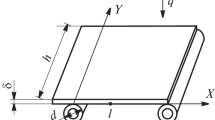Abstract
The convective heat transfer of the plume of a 120-N thruster is investigated experimentally and numerically. Numerical results agree well with experimental results in that there is a nonlinear decrease in convective heat transfer with an increasing cone angle. It is also found that convective heat transfer decreases with increasing distance from the thruster outlet. Furthermore, the convective heat transfer of the plume mainly concentrates within a 35° cone angle and the heat flux decreases to the same order as solar radiation at the Earth’s surface when the cone angle exceeds 60°. The results of the study will help improve spacecraft design.
Similar content being viewed by others
References
Wang T S. Multidimensional unstructured-grid liquid rocket-engine nozzle performance and heat transfer analysis. J Propul Power, 2006, 22: 78–84
Xiao Z, Cheng H, Zhou H. Plume interaction in parallel multi-thrusters propulsion system and the effect on backflow. In: Proceedings of the 9th AIAA/ASME Joint Thermophysics and Heat Transfer Conference. San Francisco: AIAA, 2006. 2006–3599
Markelov G N. Plume Impingement analysis for aeolus spacecraft and gas/surface interaction models. J Spacecraft Rockets, 2007, 44: 607–618
Burt J M, Boyd I D. High altitude plume simulations for a solid propellant rocket. AIAA J, 2007, 45: 2872–2884
Lee K H, Choi S W. Interaction effect analysis of thruster plume on LEO satellite surface using parallel DSMC method. Comput Fluids, 2013, 80: 333–341
He B, Zhang J, Cai G. Research on vacuum plume and its effects. Chin J Aeronaut, 2013, 26: 27–36
Yim J T, Reed B D, McLean C H. Green propellant infusion mission plume impingement analysis. In: Proceedings of the 49th AIAA/ASME/SAE/ASEE Joint Propulsion Conference. San Jose: AIAA, 2013. 2013–3850
Yim J T, Sibe F, Lerardo N. Plume impingement analysis for the european service module propulsion system. In: Proceedings of the 50th AIAA/ASME/SAE/ASEE Joint Propulsion Conference. Cleveland: AIAA, 2014. 2014–3883
Chae J, Baek S W. DSMC analysis of bipropellant thruster plume impingement on a geostationary spacecraft. J Mech Sci Tech, 2016, 30: 4621–4632
Kuo Y D, Smith N S A, Honnery D R. Experimental study of surface heating by a high speed exhaust plume. Exp Thermal Fluid Sci, 2016, 71: 138–145
Cataloglu A, Eckert K. Launcher plume effect on the satellite. In: Proceedings of the 46th International Conference on Environmental Systems. Vienna: ICES, 2016. 2016–2114
Bin F, Rafi M, Deepu M. Wall heat transfer effects on plume structure in 2D under expanded parabolic micro-nozzles. In: Proceedings of the 6th International and 43rd National Conference on Fluid Mechanics and Fluid Power. Allahabad: FMFP, 2016. 2016–2298
Votta R, Trifoni E, Pezzella G, et al. Numerical investigation of RCS jet interaction and plume impingement for mars precision landing. In: Proceedings of the 8th AIAA Theoretical Fluid Mechanics Conference. Denver: AIAA, 2017. 2017–3350
Wang W, Cai G, Zhou J. Large-scale vacuum vessel design and finite element analysis. Chin J Aeronaut, 2012, 25: 189–197
Papp J L, Wilmoth R G, Chartrand C C, et al. Simulation of high-altitude plume flow fields using a hybrid continuum CFD/DSMC approach. In: Proceedings of the 42nd AIAA/ASME/SAE/ASEE Joint Propulsion Conference and Exhibit. Sacramento: AIAA, 2006. 2006–4412
Tang Z, He B, Cai G. Investigation on a coupled Navier-Stokes-Direct Simulation Monte Carlo method for the simulation of plume flowfield of a conical nozzle. Int J Numer Meth Fluids, 2014, 76: 95–108
Sun Q, Boyd I D, Candler G V. A hybrid continuum/particle approach for modeling subsonic, rarefied gas flows. J Comput Phys, 2004, 194: 256–277
He X, He B, Cai G. Simulation of rocket plume and lunar dust using DSMC method. Acta Astronaut, 2012, 70: 100–111
He B, He X, Zhang M, et al. Plume aerodynamic effects of cushion engine in lunar landing. Chin J Aeronaut, 2013, 26: 269–278
Shen C. Rarefied Gas Dynamics. Berlin Heidelberg: Springer-Verlag, 2005. 168–171
Author information
Authors and Affiliations
Corresponding author
Rights and permissions
About this article
Cite this article
Zhang, M., Cai, G., He, B. et al. Experimental and numerical analysis of the heat flux characteristic of the plume of a 120-N thruster. Sci. China Technol. Sci. 62, 1854–1860 (2019). https://doi.org/10.1007/s11431-018-9373-8
Received:
Accepted:
Published:
Issue Date:
DOI: https://doi.org/10.1007/s11431-018-9373-8



